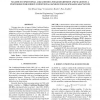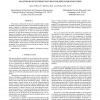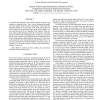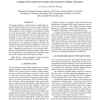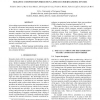ICASSP
2008
IEEE
14 years 6 months ago
2008
IEEE
Prosody is an important cue for identifying dialog acts. In this paper, we show that modeling the sequence of acousticprosodic values as n-gram features with a maximum entropy mod...
ICASSP
2008
IEEE
14 years 6 months ago
2008
IEEE
With the development of voice transformation and speech synthesis technologies, speaker identification systems are likely to face attacks from imposters who use voice transformed ...
ICASSP
2008
IEEE
14 years 6 months ago
2008
IEEE
This paper shows how to improve Hidden Conditional Random Fields (HCRFs) for phone classification by applying various speaker adaptation techniques. These include Maximum A Poste...
ICASSP
2008
IEEE
14 years 6 months ago
2008
IEEE
In this research, an iterative and unsupervised Turbo-style algorithm is presented and implemented for the task of automatic lexical acquisition. The algorithm makes use of spoken...
ICASSP
2008
IEEE
14 years 6 months ago
2008
IEEE
We present a framework for speech recognition that accounts for hidden articulatory information. We model the articulatory space using a codebook of articulatory configurations g...
ICASSP
2008
IEEE
14 years 6 months ago
2008
IEEE
Language model (LM) adaptation is often achieved by combining a generic LM with a topic-specific model that is more relevant to the target document. Unlike previous work on unsup...
ICASSP
2008
IEEE
14 years 6 months ago
2008
IEEE
Networked embedded acoustic sensors and imagers allow scientists to observe biological and environmental phenomena at high sampling rates and multiple scales. Such sampling can cr...
ICASSP
2008
IEEE
14 years 6 months ago
2008
IEEE
A top-down task-dependent model guides attention to likely target locations in cluttered scenes. Here, a novel biologically plausible top-down auditory attention model is presente...
ICASSP
2008
IEEE
14 years 6 months ago
2008
IEEE
This paper describes a simple method for significantly improving Tandem features used to train acoustic models for large-vocabulary speech recognition. The linear activations at ...
ICASSP
2008
IEEE
14 years 6 months ago
2008
IEEE
A knowledge representation formalism for SLU is introduced. It is used for incremental and partially automated annotation of the MEDIA corpus in terms of semantic structures. An a...

